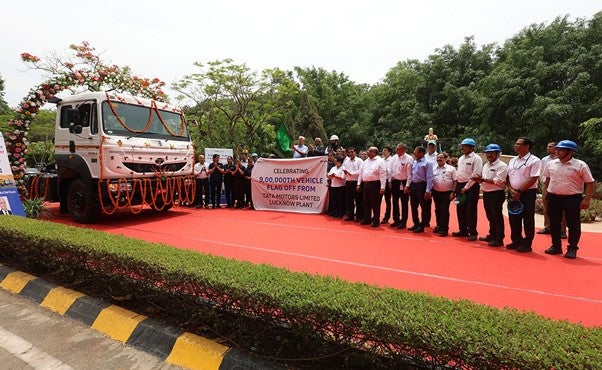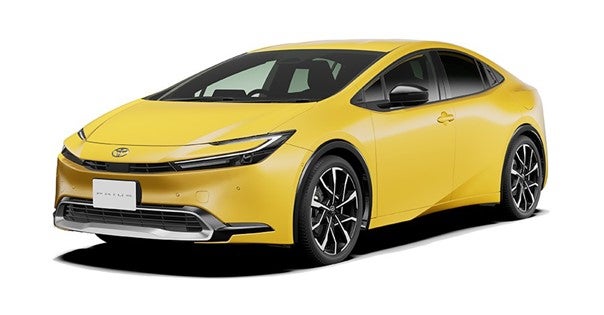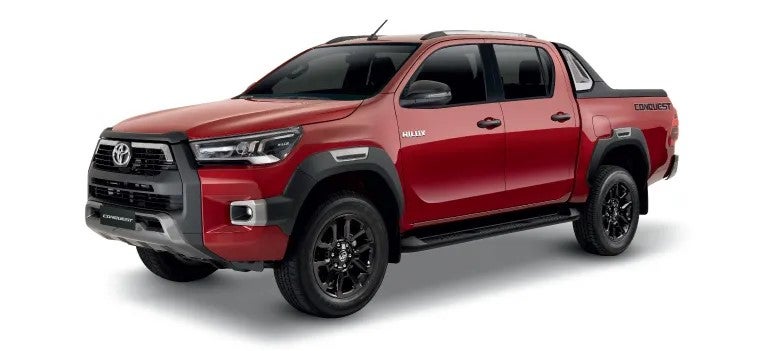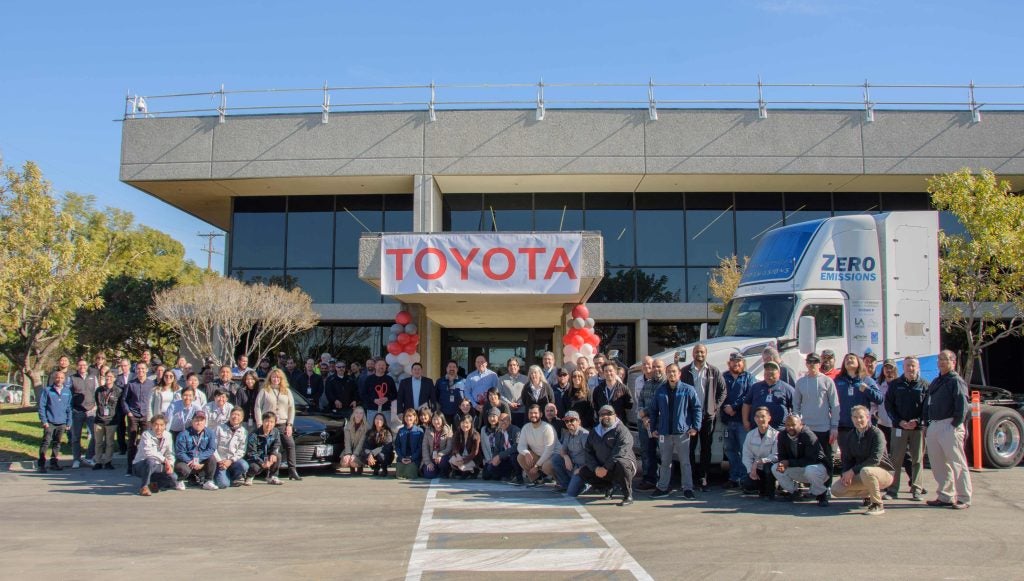
Tony Pugliese met with Motonubo Takemoto, the President of Toyota Motor Asia-Pacific based in Singapore, to discuss the company’s strategy and prospects in the region. Since the onset of the 1997-98 regional crisis, Toyota has gradually increased its share of the ASEAN vehicle market, thanks mainly to a strong recovery in its light commercial vehicle sales. Last year, Toyota accounted for almost 22% of new vehicle sales in this region, but these gains have been made against a significantly impaired competition. Some of the weaker players struggled to keep their dealer networks operating during the crisis years, and some withdrew altogether from certain markets. With competition now strengthening, it remains to be seen whether Toyota can hold on to its gains.
Vehicle demand in the ASEAN region fell sharply in 1998 overall, as the financial crisis enveloped all countries in the region. Volumes fell 63% that year, compared with 1997 when the crisis was still spreading. With a drop in demand of this magnitude, no manufacturer remained unaffected and few have since made a profit. Sales networks, particularly those comprising independent dealers, have been severely impacted by the drop in business volumes.
Toyota’s performance in ASEAN vehicle market, 1997-2000
| 1997 | 1998 | 1999 | 2000 | |
| ASEAN vehicle sales | 1,344,292 | 492,424 | 734,718 | 1,093,852 |
| Toyotas sales in ASEAN | 258,294 | 90,573 | 148,562 | 239,172 |
| Toyota’s ASEAN market share | 19.2 | 18.4 | 20.2 | 21.9 |
Vehicle sales in the ASEAN region amounted to close to 1.1m units in 2000, equivalent to around 75% of the pre-crisis peak demand of 1.46m unit sales generated in 1996. Although the initial bounce back from the crisis was impressive, ASEAN vehicle demand has yet to make a full recovery, and this may take quite a few years yet. In the countries hardest hit by the crisis, such as Indonesia, Philippines and Thailand, consumer purchasing power has a long way to go to return to pre-crisis levels. Unemployment has not fallen significantly and wages have not kept up with currency depreciation and other sources of inflation. The majority of the populations in the ASEAN countries remain much poorer that they were five years ago. This year, vehicle sales in the region will be at best flat, and are unlikely to improve significantly in 2002.
Toyota’s own sales in the region last year amounted to more than 92% of its1997 sales volumes, while overall demand had recovered by 80% in the same period. Sales of its two best-selling models, the Hilux pickup truck and the Kijang utility vehicle, actually exceeded 1997 levels in 2000. In Thailand, ongoing rural fiscal stimulus has helped the pickup truck market recover strongly. A full model changeover has helped the Kijang perform strongly against competing models. In the passenger car and recreational vehicle segments, Toyota’s performance has been more subdued.
How well do you really know your competitors?
Access the most comprehensive Company Profiles on the market, powered by GlobalData. Save hours of research. Gain competitive edge.

Thank you!
Your download email will arrive shortly
Not ready to buy yet? Download a free sample
We are confident about the unique quality of our Company Profiles. However, we want you to make the most beneficial decision for your business, so we offer a free sample that you can download by submitting the below form
By GlobalDataToyota Motor sales in the ASEAN region by model, 1997-2000
| fdd | Segment | Import status | 1997 | 1998 | 1999 | 2000 |
| Passenger Cars | ||||||
| Scarlet/Echo | B | CBU | 1,300 | 117 | 185 | 549 |
| Soluna | Lower C | CKD | 27,485 | 7,915 | 11,708 | 22,174 |
| Corolla | Upper C | CKD | 35,760 | 17,023 | 22,031 | 27,593 |
| Camry | D | CKD | 4,529 | 2,008 | 7,454 | 9,316 |
| Corona | D | CBU | 3,947 | 1,690 | 966 | 613 |
| Crown | E | CBU | 767 | 1,026 | 1,010 | 1,641 |
| Lexus | D/E | CBU | 220 | 307 | 549 | 680 |
| Total Toyota cars | 74,008 | 30,086 | 43,903 | 62,566 | ||
| Total ASEAN cars | 617,699 | 261,552 | 387,024 | 509,480 |
| Commercial vehicles | ||||||
| Land cruiser | SUV | CKD | 4,089 | 890 | 1,040 | 1,620 |
| Prado | SUV | CBU/CKD | 5,220 | 815 | 575 | 613 |
| RAV4 | SUV | CBU | 695 | 628 | 390 | 767 |
| Lexus | SUV | CBU | 0 | 0 | 0 | 120 |
| Previa | MPV | CBU | 0 | 0 | 0 | 28 |
| Picnic | MPV | CBU | 44 | 154 | 199 | 198 |
| Hilux | Pick-up truck | Local | 55,744 | 26,159 | 48,210 | 57,564 |
| Kijang/Tamaraw | Utility vehicle | Local | 92,052 | 23,186 | 40,778 | 93,067 |
| Hiace | Van | Local | 15,627 | 5,992 | 9,311 | 14,268 |
| Lite-Ace | mini-bus | CBU | 858 | 825 | 801 | 996 |
| Dyna | Medium truck | Local | 9,957 | 1,838 | 3,355 | 7,365 |
| Total Toyota commercial vehicles | dfg | dfg | 184,286 | 60,487 | 104,659 | 176,606 |
| Total ASEAN commercial vehicles | dfg | dfg | 726,593 | 230,872 | 347,694 | 584,372 |
Toyota’s challenge now is to retain the market share gains it has made in the last few years. Its industrial infrastructure in the region reflects a period when market protectionism was much higher than it is now. It has eight assembly plants in the region, and the production overlap is significant. At least two of these plants came on stream just before the Asian economic crisis, when regional vehicle demand looked like it could only increase. It has significant overcapacity in this region as a result, and its main focus is now to continue to reduce costs to maintain its competitive edge. For the moment, Toyota does not intend to close any of its ASEAN assembly plants, mostly in the hope that demand will continue to recover in the medium and long term.
With import tariffs reduced significantly in the Philippines and Indonesia, and with local content regulations having been scrapped in most markets, opportunities for new entrants have increased. The South Korean manufacturers have made significant progress with CBU imports, and are establishing car assembly plants in the region too. European and US manufacturers are also strengthening their operations and bringing more and more models into the market. Toyota’s performance in the RV segments, for example, has been poor as a result and the company is looking for ways to change this.
It is looking at increasing standardisation of parts and platforms in the region, starting with the Hilux and Kijang ranges, which are likely to share a platform once they are replaced in 2003-04. It is also planning to expand its commercial vehicle range with the collaboration of Hino, though it has yet to decide what synergies can be generated with Daihatsu, if any. In the car sector, it is looking at replacing the Soluna with a model that will reflect a less affluent core market.
 Interview
Interview
Takemoto overlooks Toyota Motor’s operations in the ASEAN region and is responsible for marketing, sales, trading and management services. He has been with Toyota since 1969 and has held a number of senior positions within the group during this time. Previously, he was the General Manager of Toyota Motor’s Asia Division, based in Japan. Before that, he was president of Toyota Motor Thailand.
Given the deteriorating global economic outlook, has Toyota Motor revised its short-term forecasts for the ASEAN region?
Demand for vehicles in the ASEAN markets has been hit hard by the regional crisis of 1997-98, and since 1999 most markets have been in recovery phase. All companies have had a very difficult time. Vehicle demand in the region dropped very sharply, and some markets have not yet fully recovered from the crisis. Our current forecasts differ from market to market, with some like Thailand for example and the Philippines, taking a lot longer to recover than others.
Has your view on the short-term outlook for demand changed since the terrorist attack on the USA on September 11th? Are you more pessimistic now about demand in the region than you were before the attack?
The terrorist attacks in the USA are indeed causing a business slowdown, with the financial and distribution sectors in the USA particularly affected. This is having an impact on the US economy as a whole at the moment, but we believe that the US’s strong economic fundamentals and resourcefulness will help its economy recover quickly. At this stage it is too difficult to see what the effects will be on demand in our region. For the moment, Toyota is not revising any of its plans for this region as a result of last month’s events, but we will be monitoring developments very closely in the coming months.
Is Toyota still expecting the ASEAN Free Trade Agreement to move ahead as scheduled, or do you see any potential delays as economies slow down?
We definitely see the ASEAN region becoming a single integrated market. For Malaysia it is difficult to say, because its automotive industry is a highly political issue. We hope that it will implement AFTA directives, but we can only wait and see what will happen.
How will Toyota structure itself industrially once AFTA is implemented, in specific terms?
First of all we have concentrated on developing a pan-ASEAN component supply base, so that components can have regional economies of scale early on. We are pushing our operations in the ASEAN to eventually become part of our globalisation programme. In the meantime, we want our vehicle assembly plants in the region to become more specialised, to enhance economies of scale further. That will involve each facility exporting models to other markets in the region, and this will help us maintain our competitive edge. That is why AFTA implementation is essential.
Has Toyota already decided which models will be produced at each plant?
Yes, we have already started to designate models to plants in the region. That is, in which countries certain models will be produced. We are still in the process of doing that.
Will the actual implementation be gradual, as new models are introduced and re-tooling is required?
Yes. It will be done model by model.
What role do you expect the Philippines and Indonesia will play in Toyota’s future plans?
We have two vehicle plants in Indonesia, and two also in the Philippines. For the moment, we have overcapacity in the region, and this is an important factor when planning our future industrial strategy for the region.
Of course in both these countries, construction of the second plants was completed just before the Asian economic crisis of 1997-98.
That is precisely right. I hope that demand in the region can recover enough to justify this capacity. Our capacity utilisation is too low at the moment, and we need to use our facilities a lot more efficiently than we are at the moment.
In the ASEAN region, Toyota has eight vehicle assembly plants: one in each of Vietnam and Malaysia, two in each of Thailand, Philippines and Indonesia. Will Toyota realistically be able to keep them all going in the long term?
We would like to use all of this capacity, or as much as possible of it. Most of our plants in this region supply their local markets, and this makes things more difficult for us. However, we do not intend to close any of our plants in the region. We need to generate export demand for these plants to use up the spare capacity.
Corporate profile – |
Would Toyota introduce more locally produced models?
If you look at the product line-up we have in the region, it has been put in place when all countries had component localisation legislation in place. Meeting these requirements was a very complicated process, particularly with having to deal with the bureaucratic procedures and legislation. But now component localisation has been removed, and external tariffs in many markets have been brought down. We have to put a product strategy in place for the region to address these developments.
There is local taxation that will differentiate these markets and mass product requirements, such as luxury taxes and excise tax concessions. These are outside the AFTA agreement.
Yes. These relate to individual government policies, and have ensured that some key local models enjoy a mass market, such as utility vehicles in Indonesia and pick-up trucks in Thailand. This is unlikely to change significantly, but at the same time we play a big role in these market segments.
How does Malaysia fit in with your regional industrial strategy?
This is a key issue, and we hope it will join AFTA so the ASEAN region can develop a significant common market for vehicles.
Would you realistically expect to use the Malaysian facilities as a regional supply base?
We do see some possibilities for our Malaysian joint venture with UMW, in which we have a 39% stake. We already export components to other production facilities in the region from Malaysia. As I mentioned earlier, we would like to keep all facilities in the region operational, and hopefully demand will recover enough to justify this.
But that involves at least eight plants. Would you be looking at making eight models in the region?
Well, in the passenger car sector we already produce three core models – the Soluna, Corolla and Camry. For the commercial vehicle markets, our core products are the Kijang, Hilux and Dyna.
New competitors are coming in and eroding Toyota’s traditional dominance of key market segments. The Koreans in particular have done extremely well. In Indonesia, wealthy buyers have bought Kia Carnivals when replacing the Kijang, for example. Ford has made strong progress in Thailand and GM and its affiliates are increasingly hungry for regional market share. How is Toyota responding to this pressure?
As I mentioned before, in the past it has been impossible to supply a large variety of models to ASEAN markets because of localisation regulations and import tariffs. Importing CBUs was out of the question. Now tariffs are lower and companies such as the Koreans have been successful with imports. The Americans and Europeans are also returning. At Toyota, we already have a manufacturing infrastructure in place, and high levels of regional content. We will have to use this infrastructure to our advantage, and stay ahead of the newcomers in terms of price competitiveness.
In terms of new products, are you planning to introduce models in these growing segments, such as MPVs and compact SUVs?
Models such as the Kia Carnival have become popular in markets such as Indonesia. We are currently studying how to penetrate these market segments more successfully.
Will you be re-tooling plants so that they will have the flexibility to produce a number of different models based on the same platform? (For example, compact MPVs sharing production lines with saloon models?)
At some of our plants, we produce different models such as saloon cars and utility vehicles on the same production lines using flexible tools and jigs. For example, Toyota Motor Vietnam has a flexible welding line where the Camry, Corolla and Zace utility vehicle are produced. However, we are not producing different models based on the same platform at any of our plants in this region, and we expect to continue to operate in this way.
The Kijang is increasingly seen as an old workhorse, even though it has been revamped. Is Toyota planning to modernise the concept of this model?
The Kijang is something like a national vehicle in Indonesia, in as much as it is a utility vehicle developed for the Indonesian mass market. It is the best-selling vehicle in that market, because it accommodates the transportation needs of the country, it is affordable and highly flexible as a vehicle. We are not going to change this concept.
How can Toyota reduce costs and enhance competitiveness? Could the Kijang share its platform with the Hilux pick-up truck, for example?
That is one of the possibilities for the future, yes. Standardising platforms is essential for us in developing new products, and to keep them cost-competitive.
There has been a lot in the press about increased collaboration with Daihatsu. Is this going to be extended to the ASEAN market? In this region, virtually no synergies have yet been developed between the two companies.
Toyota increased its holding in Daihatsu Motor to 51% in 1999. Since then, collaboration between the two companies has increased. As far as Asia is concerned, the industrial set-up varies from country to country, whether it is in Indonesia, Malaysia, and so on. It will not be easy for us to generate synergies in this region with Daihatsu, and it will take some time at least. Our main priority is to streamline our operations and to become more competitive.
As far as I can see, Daihatsu has two operations in the ASEAN. Its Perodua joint venture in Malaysia, and its joint venture in Indonesia with Astra International. Daihatsu withdrew from Thailand as the Asia crisis set in. Are there no potential product synergies between Daihatsu and Toyota, for example to sell the Daihatsu Terios in Thailand under the Toyota badge? Or indeed other synergies along these lines, in the small car sector, for example?
Under current import regulations, it will be difficult, especially with Perodua being a national car company. Perodua is still majority-owned by Malaysian concerns, and this makes it difficult for us to collaborate with it. But it would perhaps be easier to work with Daihatsu’s Indonesian operation. In the future, it could be possible to sell some Daihatsu models under the Toyota brand. No decision has been made yet with regard to collaborating with Daihatsu in the ASEAN region. – we are still in discussion with Daihatsu. There is potential for collaboration, but what you have seen so far in the press is speculation.
Wouldn’t it make sense to sell the Terios under the Toyota brand in Thailand, where Daihatsu no longer has a presence of its own?
Perhaps, but there isn’t really a big market in Thailand for these models.
Honda seems to think so. It sells around 5,000 CR-Vs per year.
Perhaps, but I still think the overall market is too small.
The success of the Soluna model in the region was undermined by the regional economic crisis of 1997-98. You’re obviously looking at updating this model at the moment. What stage is this at, and what lessons have been learnt from the current programme?
When we introduced the Soluna, we were addressing the growing need for affordable private motorisation in the region. The biggest market for this model has remained Thailand. This was before the regional economic crisis, and the price was right for the first-time buyers that we were targeting. During and since the crisis, prices in local currency terms have had to increase substantially. Household income and purchasing power among this customer group has not kept up with inflation. That is why demand for this model has not recovered so strongly. I’m sure this customer group will come back again, but it will take time for purchasing power to return to previous levels.
With the next generation Soluna, we have to take this into account. The customer base that we previously targeted when we launched the Soluna is now much smaller. We will have to make the next generation even more competitive, to give it a large enough customer base.
Are you going to be looking at new ideas for your Asia Car programme? There is talk of you replacing the Soluna with a model based on the Yaris/Vitz.
Yes, a programme is now underway to replace the current Soluna model. We still believe there will be a mass market for small cars such as the Soluna in the Asia region. In China, for example, the Tianjin Toyota Motor joint venture will produce a new passenger car at an annual rate of 30,000 units from 2002. It will use the same platform as the Vitz/Platz.
How are you planning to collaborate with Hino Motors, which has also become a consolidated subsidiary of Toyota Motor in the last couple of months?
We recently announced a joint programme to produce a two ton truck with Hino in Japan. This joint programme is also likely to be extended into the ASEAN markets.
Where will it be produced?
In both Thailand and Indonesia.
Which will be the biggest market for this model?
For the moment, we expect Indonesia will be the biggest market for this model.
When people talk about the ASEAN regional market, it is often seen as an end in itself, rather than a stepping stone to develop a globally competitive industry. Toyota’s pick-up truck plant in Thailand has already adopted a much broader role. Do you see other vehicle plants fulfilling a similar role in the future?
There are many studies going on at the moment, but nothing has been decided yet. We see Thailand as the strongest part of our ASEAN operations. Our ASEAN operations supply many parts, including engines, to markets outside the region. I’m not sure whether other plants will export CBU vehicles to markets outside the region. At least not in the foreseeable future.
|






